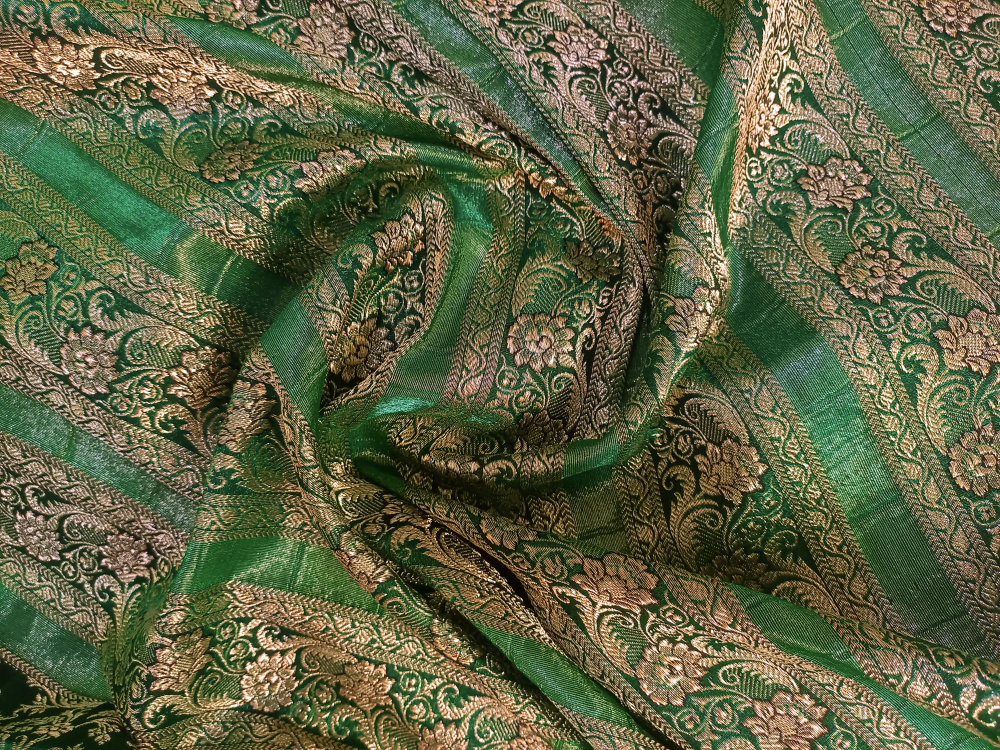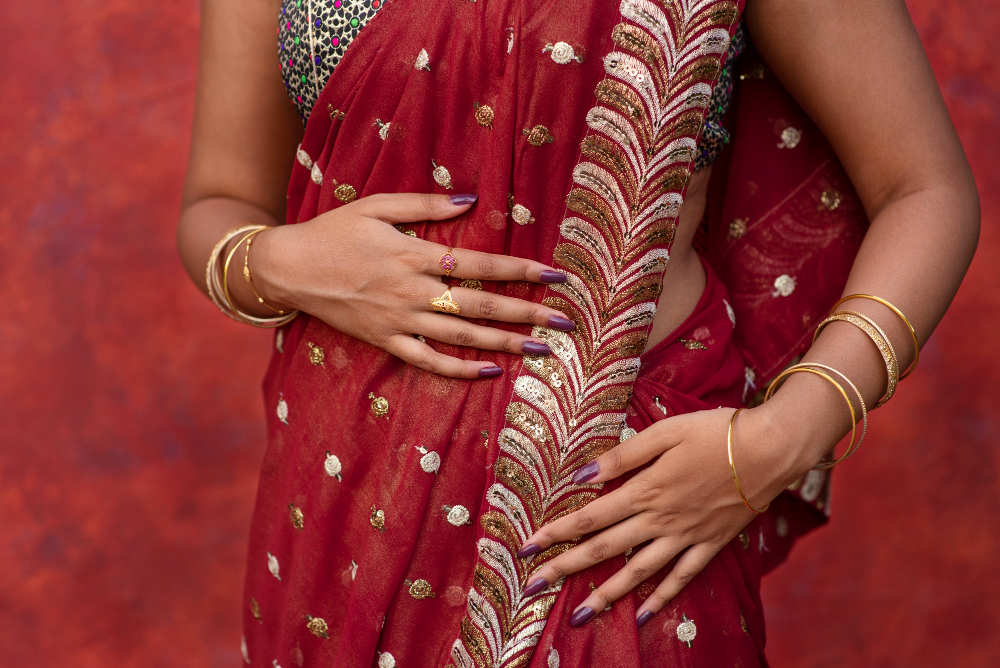Summary
- The saree is one of the most iconic garments in the world, representing India’s colorful culture.
- With deep roots in tradition and endless possibilities for design, it continues to inspire fashion.
- Experience the future of fashion with Audaces360!
If this type of clothing is new to you, know that there are many types of sarees in India. And each has its own fabric, weaving style, and cultural story. Some are famous for their rich embroidery, while others stand out because of their prints and textures.
As a fashion designer, learning about different types of sarees can open new doors. You can take inspiration and explore how traditional techniques can mix with modern silhouettes.
In this article, we’ll explore 18 types of sarees that are worth adding to your fashion repertoire. Whether you’re working on a new collection or seeking fresh ideas, you’ll find something here to spark your creativity.
Let’s take a closer look at the beauty and variety behind each style. Happy reading!
Sumário
Why should every fashion designer know the types of sarees?
Knowing the types of sarees helps designers offer more variety. They can vary from lightweight cotton sarees for everyday use to rich silk sarees for special occasions. By learning about them, you can create pieces that connect with different markets.
With the right knowledge, you can use a traditional print in a new way or mix a classic saree fabric with a modern shape. This blend of old and new often leads to fresh, exciting ideas.
Also, understanding sarees can help designers respect cultural values. Some types of sarees are special for regional celebrations, weddings, and festivals.
Knowing this helps avoid mistakes and shows clients that you care about their traditions and style.
Learn more: Discover Indian fashion with stories, styles and designers
18 most popular types of sarees around the world
The saree is one of the most graceful and versatile garments in fashion. It comes in different intricate patterns that reflect regional craftsmanship, textile heritage, and evolving design trends.
From the vibrant silks of the South Indian region to the delicate weaves of the East, each type of saree tells a unique story.
Here are the key types of sarees:
1) Banarasi saree

The Banarasi saree is one of the most famous types of sarees in India. Originating from Varanasi, this saree has rich silk fabric and intricate gold or silver brocade work. Floral motifs, peacocks, and foliate patterns are common in traditional Banarasi designs.
This type of saree is the choice for weddings and grand celebrations due to their luxurious appearance.
2) Kanjivaram saree
The Kanjivaram saree comes from Tamil Nadu and is renowned for its vibrant colors and wide contrast borders.
Many people call this saree the queen of silks, because weavers use pure mulberry silk to create it. It features bold motifs like temple borders, checks, stripes, and floral patterns.
3) Chanderi saree
Chanderi sarees are lightweight, elegant, and ideal for both formal and casual occasions. Originating from Chanderi in Madhya Pradesh, weavers use silk, cotton, or a blend to create them.
These sarees are famous for their sheer texture and glossy finish.
4) Sambalpuri saree
Sambalpuri sarees come from Odisha and are famous for their traditional tie-dye technique called Ikat. The intricate designs, often inspired by nature and religious symbols, are handwoven with great skill.
Common motifs include wheels, flowers, and animals, reflecting Odisha’s rich cultural heritage.
Learn more: Inside the career of Indian designer Manish Malhotra
5) Tussar silk saree
To create this type of saree, weavers use a wild silk found mainly in India’s central and eastern regions.
Unlike cultivated silk, tussar silk has a natural golden sheen and a slightly coarse texture that adds to its charm. These sarees are lightweight and breathable, ideal for warm climates.
6) Bandhani saree
Bandhani sarees originate from Gujarat and Rajasthan and are famous for their distinctive tie-dye patterns.
The name Bandhani comes from the Sanskrit word “bandh,” meaning to tie. Artisans create intricate dots, waves, and stripes by tying small sections of fabric before dyeing.
7) Patola saree
Patola sarees are double ikat silk sarees from Gujarat, known for their complex weaving process and stunning geometric patterns. Creating a Patola saree can take several months due to the precision required in aligning threads before weaving.
People value these sarees for their rich colors and intricate designs. They often include motifs like flowers, birds, and elephants.
Learn more: All you need to know about global industrial production
8) Kota doria saree
Kota Doria sarees come from Kota in Rajasthan and are famous for their lightweight, sheer texture. Made from a blend of cotton and silk, these sarees have a unique square check pattern called “khat,” created by weaving fine threads.
9) Muga silk saree
Weavers in Assam create Muga silk sarees using a rare type of silk. It has a natural golden color and glossy finish. Muga silk is also highly durable and gets better with age, making these sarees a valuable investment.
The weaving of Muga silk is an ancient art, often featuring elegant designs that highlight its natural beauty.
Discover our secret! In this exclusive masterclass, we show you step by step how to build a digital collection from scratch. Watch now:
10) Kalamkari saree
Artisans in Andhra Pradesh and Telangana create Kalamkari sarees using a hand-painting technique with natural dyes. The word “Kalamkari” means “pen work,” which reflects the detailed brushwork used to create complex designs. Themes often include mythological stories, flowers, and animals.
11) Paithani saree
Weavers from Maharashtra craft Paithani sarees with fine silk threads and vibrant colors. The sarees have wide borders with peacock and lotus motifs, symbolizing beauty and purity. Their rich texture and intricate designs show the skill and dedication of the artisans.
12) Baluchari saree
Baluchari sarees come from West Bengal, where craftsmen weave stories from Hindu epics onto the the loose end of the saree. The weaving technique uses silk threads to create detailed, narrative scenes, often featuring gods, goddesses, and royal life.
13) Jamdani saree
Jamdani sarees are created through a technique that weaves floral and geometric patterns directly into cotton fabric. The process involves a lot of skill and patience, producing lightweight yet sturdy sarees.
Learn more: How does the Asia Pacific market impact fashion?
14) Dhakai saree
Dhakai sarees come from Dhaka, Bangladesh, famous for their intricate handwoven patterns using fine cotton threads. The sarees showcase floral and geometric designs with delicate craftsmanship passed down through generations.
15) Venkata Giri saree
Venkatagiri sarees come from Tamil Nadu and feature fine cotton or silk with simple, elegant designs. The sarees often have narrow borders with gold or silver zari work that adds a subtle shine. Weavers focus on creating lightweight and comfortable fabric.
16) Ilkal saree
Ilkal sarees come from Karnataka and stand out with their bold, geometric borders and contrasting pallus. Artisans weave cotton or silk fabric using a method called Tope Teni, which joins two different types of yarn during weaving.
These sarees have a rustic charm and are common for weddings and festivals. Designers often admire Ilkal for its vibrant colors and the striking visual impact it creates.
17) Gota patti saree
This type of saree originates from Rajasthan. It usually features decorative applique work using small pieces of gold or silver ribbon stitched onto the fabric. The technique gives the saree a sparkling, festive look. Women wear Gota Patti sarees during weddings and celebrations.
18) Kasavu saree (Kerala)
Kasavu sarees come from Kerala and have a simple, elegant design with a white or off-white base and golden borders. Traditionally woven from cotton, they reflect the minimalist beauty of Kerala’s culture.
People wear Kasavu sarees during festivals like Onam and weddings. Their timeless look and cultural significance make them a favorite among fashion lovers seeking classic beauty.
Learn more: A step-by-step guide on how to draw a dress from scratch
How can you choose the right types of sarees for your collection?

Get to know your clients’ style
Before you select any saree types, take time to understand who you’re designing for. What age group do they belong to? Do they prefer traditional styles or modern interpretations?
Learning about your clients’ lifestyle, preferences, and cultural background helps you design sarees they’ll actually want to wear.
Consider current fashion trends
Fashion trends shift every season, and sarees are no exception. Watch what’s happening on runways, in fashion weeks, and even on social media platforms.
You’ll notice patterns in colors, fabrics, and styling preferences that can guide your design choices.
Define the theme of your collection
Every strong collection has a clear theme or concept. Ask yourself what message or mood you want to communicate. Are you celebrating a festival, focusing on bridal wear, or telling a cultural story through fabric and design?
Once you have a theme, it becomes easier to narrow down the types of sarees that fit. A luxury bridal collection might call for Kanjivaram and Banarasi sarees. Meanwhile a summer line could feature lightweight styles like Chanderi or Kota Doria.
Learn more: Explore reasons for companies to invest in ethical fashion
Think about the climate and season
Different fabrics work better in different weather conditions. Cotton and chiffon sarees feel cool and breathable in summer. At the same time, silk and heavier weaves provide warmth during winter.
Choose your materials based on the season in which your collection will launch.
Is it possible to preview how the saree will drape before production?
Yes, with today’s technology, designers can preview how a saree will drape even before producing a single sample.
3D fashion design tools allow you to visualize the fabric on a virtual model. They have the power to show you how it flows, folds, and reacts to movement. This gives you a clear idea of how your design will look in real life — without needing to cut any fabric.
Design and simulate different types of sarees with Audaces technology
Audaces is a market leader fashion technology company and a reference worldwide. Through a deep understanding of fashion creation and production, we have developed ideal solutions for each stage.
Audaces Fashion Studio
Audaces Fashion Studio is a groundbreaking innovation for fashion designers within Audaces360 multisolution.
This innovative technology empowers professionals to create smarter sketches on a 3D mannequin. It provides tools and functionalities to enhance your design process.
Its features enable you to examine fit, drape, and movement in different body types. Explore fabrics, colors, textures, and apply prints in a few clicks.
Audaces Idea
Audaces Idea is your solution for creating and applying prints to your designs.
It helps end errors and streamline communication between design and the other teams. This way, you can reduce the development cycle and ensure timely deliveries.
Audaces Idea also includes integrated tech packs and automatic pre-cost calculations. You can visualize all your creation information on a single screen during the process.
Automating technical tasks frees up your time for more design exploration!
Audaces Sofia
Meet Audaces Sofia our cutting-edge fashion Artificial Intelligence. It helps you enhance your creations with an unlimited source of inspiration.
This solution has the power to transform concepts into reality in a matter of minutes. Some simple prompts are all you need to generate print variations.
Audaces Sofia integrates with Audaces Idea and Audaces Fashion Studio. This combination provides you with the complete solution to create effortlessly
Discover Audaces360 and unlock a world of possibilities for fashion design and production. Explore our comprehensive suite of solutions today!
FAQ
Knowing the types of sarees helps designers offer more variety. They can vary from lightweight cotton sarees for everyday use to rich silk sarees for special occasions. By learning about them, you can create pieces that connect with different markets.
The most common types of sarees include Kanjivaram saree, Banarasi saree, Chanderi saree and Bandhani saree.
Know your clients’ style, consider current fashion trends, define the theme, and think about the climate and season.










